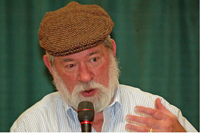Be a Storyteller: Dramatize Your Memoir or Family History Book
Biff Barnes
Many first time memoirists and family historians think that their first responsibility is to create a complete record of everything that happened. As a consequence their initial draft often reads like a list. All events great and small get equal treatment. Unfortunately these lists are missing the elements that make stories interesting and compelling: conflict, emotion and drama.
 Storyteller Tom Slattery courtesy of Irish Philadelphia Photo Essays
Storyteller Tom Slattery courtesy of Irish Philadelphia Photo Essays
A first step in adding drama to the recounting a life story, your own or that of an ancestor, is to recognize that telling a good story requires making choices. Not every memory or detail of genealogical research is of equal importance. Some are much more interesting than others. Focus on the moments in life that involve accomplishing an important goal, overcoming an obstacle or similar turning point. Some of the less significant memories will drop away and you can devote more time to providing a more detailed account of these pivotal events.
In presenting these key moments to your readers, follow Mark Twain’s famous advice to writers, “Don’t say the old lady screamed. Bring her on and let her scream.” Create scenes so your readers can watch the events unfold. Borrow the techniques of fiction to create a setting, describe the characters involved in the events, show them interacting. You can use interior monologue to deal with the thoughts and feelings of characters. You can use dialogue to bring the events to life. But, you say, some of these events occurred years, even generations ago, I don’t recall or never knew what people said. Fine. It’s okay to speculate about it. If you think about the people whose story you are telling and the situation they were in iamgine what might they have thought or felt? It’s very likely that’s what they would have said. There’s your dialogue.
That’s storytelling. It’s bound to draw your reader in.